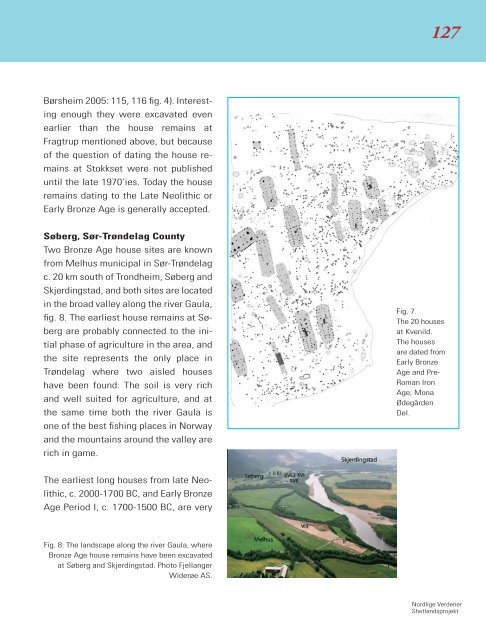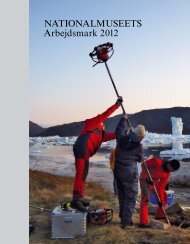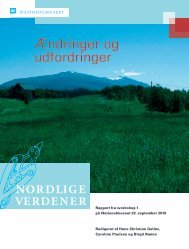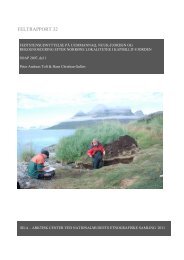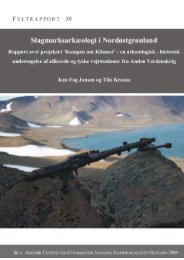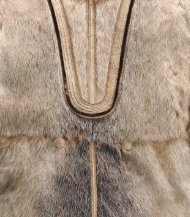The Border of Farming and the Cultural Markers - Nordlige Verdener
The Border of Farming and the Cultural Markers - Nordlige Verdener
The Border of Farming and the Cultural Markers - Nordlige Verdener
Create successful ePaper yourself
Turn your PDF publications into a flip-book with our unique Google optimized e-Paper software.
127<br />
Børsheim 2005: 115, 116 fig. 4). Interesting<br />
enough <strong>the</strong>y were excavated even<br />
earlier than <strong>the</strong> house remains at<br />
Fragtrup mentioned above, but because<br />
<strong>of</strong> <strong>the</strong> question <strong>of</strong> dating <strong>the</strong> house remains<br />
at Stokkset were not published<br />
until <strong>the</strong> late 1970’ies. Today <strong>the</strong> house<br />
remains dating to <strong>the</strong> Late Neolithic or<br />
Early Bronze Age is generally accepted.<br />
Søberg, Sør-Trøndelag County<br />
Two Bronze Age house sites are known<br />
from Melhus municipal in Sør-Trøndelag<br />
c. 20 km south <strong>of</strong> Trondheim, Søberg <strong>and</strong><br />
Skjerdingstad, <strong>and</strong> both sites are located<br />
in <strong>the</strong> broad valley along <strong>the</strong> river Gaula,<br />
fig. 8. <strong>The</strong> earliest house remains at Søberg<br />
are probably connected to <strong>the</strong> initial<br />
phase <strong>of</strong> agriculture in <strong>the</strong> area, <strong>and</strong><br />
<strong>the</strong> site represents <strong>the</strong> only place in<br />
Trøndelag where two aisled houses<br />
have been found. <strong>The</strong> soil is very rich<br />
<strong>and</strong> well suited for agriculture, <strong>and</strong> at<br />
<strong>the</strong> same time both <strong>the</strong> river Gaula is<br />
one <strong>of</strong> <strong>the</strong> best fishing places in Norway<br />
<strong>and</strong> <strong>the</strong> mountains around <strong>the</strong> valley are<br />
rich in game.<br />
Fig. 7.<br />
<strong>The</strong> 20 houses<br />
at Kvenild.<br />
<strong>The</strong> houses<br />
are dated from<br />
Early Bronze<br />
Age <strong>and</strong> Pre-<br />
Roman Iron<br />
Age; Mona<br />
Ødegården<br />
Del.<br />
<strong>The</strong> earliest long houses from late Neolithic,<br />
c. 2000-1700 BC, <strong>and</strong> Early Bronze<br />
Age Period I, c. 1700-1500 BC, are very<br />
Fig. 8: <strong>The</strong> l<strong>and</strong>scape along <strong>the</strong> river Gaula, where<br />
Bronze Age house remains have been excavated<br />
at Søberg <strong>and</strong> Skjerdingstad. Photo Fjellanger<br />
Widerøe AS.<br />
<strong>Nordlige</strong> <strong>Verdener</strong><br />
Shetl<strong>and</strong>sprojekt


